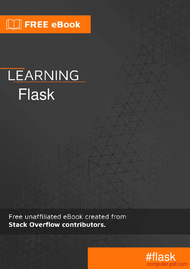Flask Tutorial PDF: Complete Guide to Web Development
This Flask Tutorial PDF is a complete guide to learning Flask, a powerful Python web framework. It covers everything from basic routing and templates to advanced topics like authentication, SQLAlchemy, and deployment using uWSGI and Nginx. Perfect for beginners and experienced developers, this tutorial provides step-by-step instructions to help you build secure, scalable web applications. Whether you're new to Flask or looking to enhance your skills, this PDF is an essential resource. Download now to start your Flask web development journey!
An overview of Learning Flask
Flask is a lightweight and flexible Python web framework, perfect for building web applications of all sizes. This Flask Tutorial PDF is a comprehensive guide designed to help beginners and advanced users master Flask.
The tutorial starts with the basics, teaching you how to install Flask, define routes, and render templates. It then progresses to more advanced topics like handling request data, implementing authentication and authorization, and using Flask-Login for user sessions. You’ll also learn how to organize your application with Flask Blueprints and create reusable components.
For database integration, the guide covers Flask-SQLAlchemy, showing you how to connect to relational databases, define models, and perform queries. It also explores Flask-WTF for form handling and validation, ensuring your applications can securely process user input.
The tutorial dives into deployment, teaching you how to deploy Flask applications using uWSGI with Nginx and Apache with mod_wsgi. You’ll also learn how to handle file uploads, implement pagination, and work with JSON data for modern web applications.
Advanced topics like class-based views, custom Jinja2 filters, and Flask signals are also included, making this guide suitable for experienced developers looking to refine their skills.
Whether you’re building a small project or a large-scale application, this Flask Tutorial PDF is an invaluable resource. With clear explanations, practical examples, and step-by-step instructions, it’s the ultimate guide to mastering Flask.
Download this PDF today and start building powerful, scalable web applications with Flask!
| Description : | Learning Flask is a free, comprehensive PDF ebook that covers everything from the basics of Flask to advanced topics like testing and working with JSON. Ideal for both beginners and experienced developers. |
| Level : | Beginners |
| Created : | February 28, 2023 |
| Size : | 243.84 KB |
| File type : | |
| Pages : | 66 |
| Author : | riptutorial |
| Licence : | Creative commons |
| Downloads : | 1161 |
More PDFs Tutorials
